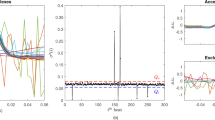Abstract
The extraction of respiration from physiological signals such as the electrocardiogram (ECG) and photoplethysmogram (PPG) has been explored for a long time. The proposed methods are mainly based on filters and features. However, the performances among methods are hardly compared and summarized. In this chapter, we focus on the studies of the typical feature-based ECG-derived respirations (EDR). The review of each method is given. The experiment is processed with rest ECG data and reference respiratory data collected synchronously over 60 s. Three parameters, waveform correlation C1, interval correlation C2, and respiratory rate RR, are introduced to evaluate each method under conditions of good and poor signal qualities. The results indicate that the optimal method should be determined by applications. For parameter C1, trough envelope-based method provides the highest similarity with reference waveform (0.8426) when the signal quality is good. However, it is easily affected by the noise, decreasing to −0.3219. For parameter C2, ECG area mean-based method has the highest similarity with intervals of reference signal (0.8162). Likewise, it performs no better than QRS complex area-based method (0.7013) when the signal quality is poor. In general, signal quality has an effect on the results of these methods.
Access this chapter
Tax calculation will be finalised at checkout
Purchases are for personal use only
Similar content being viewed by others
References
Gravelyn, T.R., Weg, J.G.: Respiratory rate as an indicator of acute respiratory dysfunction. JAMA. 244(10), 1123–1125 (1980)
Birrenkott, D., MAF, P., Watkinson, P.J., Clifton, D.A.: A robust fusion model for estimating respiratory rate from photoplethysmography and electrocardiography. IEEE Trans. Biomed. Eng. 65(99), 2033 (2018)
Walter, K., Srinivas, R., Mark, A.J., Dumont, G.A.: Multiparameter respiratory rate estimation from the photoplethysmogram. IEEE Trans. Biomed. Eng. 60(7), 1946–1953 (2013)
Charlton, P., Birrenkott, D.A., Bonnici, T., Pimentel, M.A.F., Johnson, A.E.W., Alastruey, J., Tarassenko, L., Watkinson, P.J., Beale, R., Clifton, D.A.: Breathing rate estimation from the electrocardiogram and photoplethysmogram: a review. IEEE Rev. Biomed. Eng. 11, 2–20 (2017)
Lázaro, J., Alcaine, A., Romero, D., Gil, E., Laguna, P., Pueyo, E., Bailón, R.: Electrocardiogram derived respiratory rate from QRS slopes and r-wave angle. Ann. Biomed. Eng. 42(10), 2072–2083 (2014)
Orphanidou, C., Fleming, S., Shah, S.A., Tarassenko, L.: Data fusion for estimating respiratory rate from a single-lead ECG. Biomed. Signal Process. Contr. 8(1), 98–105 (2013)
Charlton, P.H., Bonnici, T., Tarassenko, L., Clifton, D.A., Beale, R., Watkinson, P.J.: An assessment of algorithms to estimate respiratory rate from the electrocardiogram and photoplethysmogram. Physiol. Meas. 37(4), 610–626 (2016)
Zhang, P.Z., Tapp, W.N., Reisman, S., Natelson, B.H.: Respiration response curve analysis of heart rate variability. IEEE Trans. Biomed. Eng. 44(4), 321 (1997)
Ramya, K., Rajkumar, K.: Respiration rate diagnosis using single lead ECG in real time. Glob. J. Med. Res. 13, 1 (2013)
Ruangsuwana, R., Velikic, G., Bocko, M.: Methods to extract respiration information from ECG signals. In: 2010 IEEE International Conference on Acoustics, Speech and Signal Processing, pp. 570–573. IEEE, Washington, DC (2010)
Sobron, A., Romero, I., Lopetegi, T.: Evaluation of methods for estimation of respiratory frequency from the ECG. Comput. Cardiol. 37, 513 (2010)
Einthoven, W., Fahr, G., De Waart, A.: On the direction and manifest size of the variations of potential in the human heart and on the influence of the position of the heart on the form of the electrocardiogram. Am. Heart J. 40(2), 163–211 (1950)
Daniel, R., Michael, R., Pablo, L., Olle, P., Esther, P.: Depolarization changes during acute myocardial ischemia by evaluation of QRS slopes: standard lead and vectorial approach. IEEE Trans. Biomed. Eng. 58(1), 110–120 (2010)
Esther, P., Leif, S., Pablo, L.: QRS slopes for detection and characterization of myocardial ischemia. IEEE Trans. Biomed. Eng. 55(2), 468–477 (2008)
Pan, J., Tompkins, W.J.: A real-time QRS detection algorithm. IEEE Trans. Biomed. Eng. 32(3), 230–236 (2007)
Author information
Authors and Affiliations
Corresponding authors
Editor information
Editors and Affiliations
6. Appendix
6. Appendix
1.1 6.1. The Least Square Method
The least square method finds the optimal estimation, which satisfies the minimum sum of squares with original data. It is described as follows.
Assume that a regression equation with two unknown parameters, β0 and β1, is defined as follows:
Given a sequence of sample input data {x1, x2, …, xn} and corresponding output data {y1, y2, …, yn}, where n denotes the length of data. The estimated regression equation is as follows:
where b0 and b1 are the estimates of β0 and β1, respectively.
The aim is to get the parameter estimates satisfying the condition:
where yi is the corresponding value of original data x, and \( {\hat{y}}_i \) is the estimated corresponding value of original data x.
Combining Eq. (10) with Eq. (11), the condition is rewritten as follows:
Taking the partial derivative of b0, we get the expression as follows:
where \( \overline{y} \) and \( \overline{x} \) are the average values of y and x, respectively.
Substitute Eq. (13) for b0 in Eq. (12), and the partial derivative of b1 is obtained as follows:
Rights and permissions
Copyright information
© 2020 Springer Nature Singapore Pte Ltd.
About this chapter
Cite this chapter
Dong, K., Zhao, L., Liu, C. (2020). Respiratory Signal Extraction from ECG Signal. In: Liu, C., Li, J. (eds) Feature Engineering and Computational Intelligence in ECG Monitoring. Springer, Singapore. https://doi.org/10.1007/978-981-15-3824-7_13
Download citation
DOI: https://doi.org/10.1007/978-981-15-3824-7_13
Published:
Publisher Name: Springer, Singapore
Print ISBN: 978-981-15-3823-0
Online ISBN: 978-981-15-3824-7
eBook Packages: Biomedical and Life SciencesBiomedical and Life Sciences (R0)




